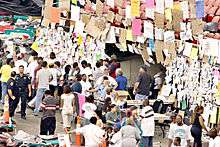Internally displaced persons in the United States
Internally displaced persons in the United States are people from the Gulf States region in the southern United States, most notably New Orleans, Louisiana, who were forced to leave their homes due to the devastation brought on by Hurricane Katrina in 2005, and were unable to return due to a multitude of factors, and are collectively known as the Gulf Coast diaspora, are by standard definition considered IDPs.[1] At their peak, hurricane evacuee shelters housed 273,000 people and, later, FEMA trailers housed at least 114,000 households.[2]

Even a decade after Hurricane Katrina, many victims who were forced to relocate were still unable to return home. In 2005, around 1,500,000 people from Alabama, Mississippi and Louisiana were forced to leave their homes due to Hurricane Katrina. Around 40% of evacuees, mostly people from Louisiana, were not able to return home. 25% of evacuees relocated within 10-miles of their previous county. 25% of evacuees relocated at least 450-miles away. 10% of evacuees relocated at least 830-miles away.[3] "Returning home can be an important step for the health and economic stability of low-income, climate-displaced families. Evidence indicates that the climate displaced, particularly those who are low income, can suffer from greater hardships than they did prior to evacuation."[3]
The population of New Orleans fell from 484,674 before Katrina (April 2000) to an estimated 230,172 after Katrina (July 2006)—a decrease of 254,502 and a loss of over half of the city's population. By July 2015, the population was back up to 386,617—80% of what it was in 2000. However, not all those who moved to the city were returning residents.[2] After Hurricane Katrina the privatization push gained momentum. With the opportunity to enact proposals that had circulated since the mid-1980s, the city council voted unanimously to demolish 4,500 units of traditional public housing. In just over a decade—from 1996 to 2007—the city managed to close 85% of the city's public housing, adopting a system of "mixed-income" projects and vouchers instead. While liberals touted it as "deconcentration," the removal project effectively (and efficiently) displaced low-income residents from areas ripe for profit-making. As a result, 16,000 families remain on the waitlist for subsidized housing.[4][5]
See also
- Internally displaced person
- Refugee
- Political asylee
- Emergency evacuation
- Kampala Convention
References
- http://www.atha.se/sites/default/files/ATHA%20IDP%20101%2002a%20IDP%20definition%20Dec%202010_0.pdf
- https://www.datacenterresearch.org/data-resources/katrina/facts-for-impact/
- Baussan, Danielle. "When You Can't Go Home". Center for American Progress. Retrieved 2020-01-12.
- "Gentrification's Ground Zero".
- Katrina and Rita IDPs are not of concern to, and therefore not counted by, UNHCR ("2005 Global Refugee Trends" (PDF)., UNHCR, Table 14, p. 94). They therefore do not appear in many international numbers. However, they are often discussed under the IDP definition. (Example: Harvard Educational Review editorial)